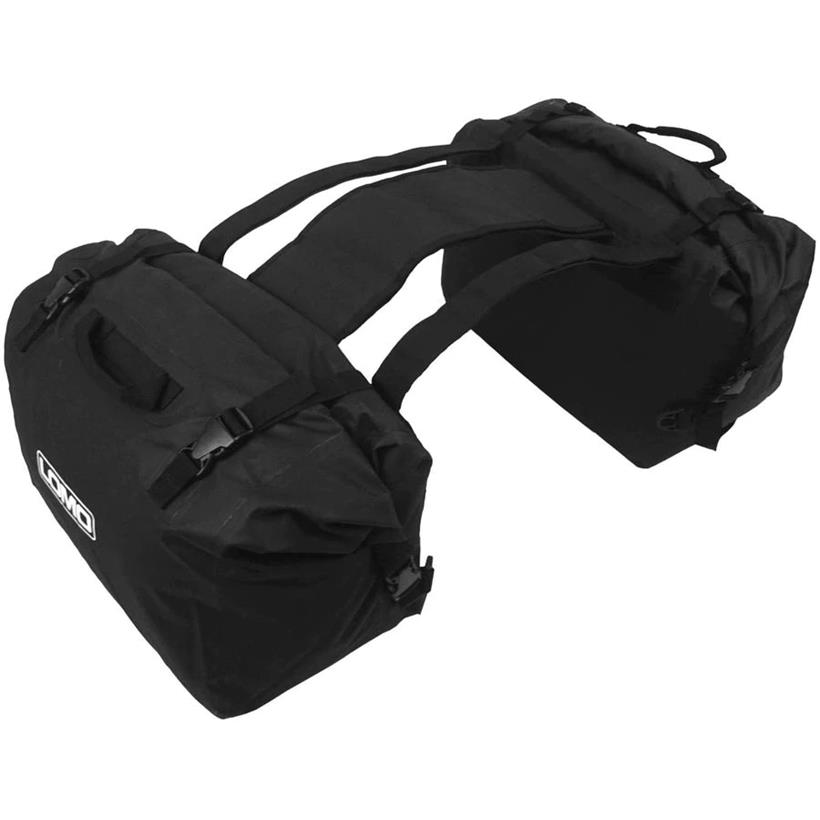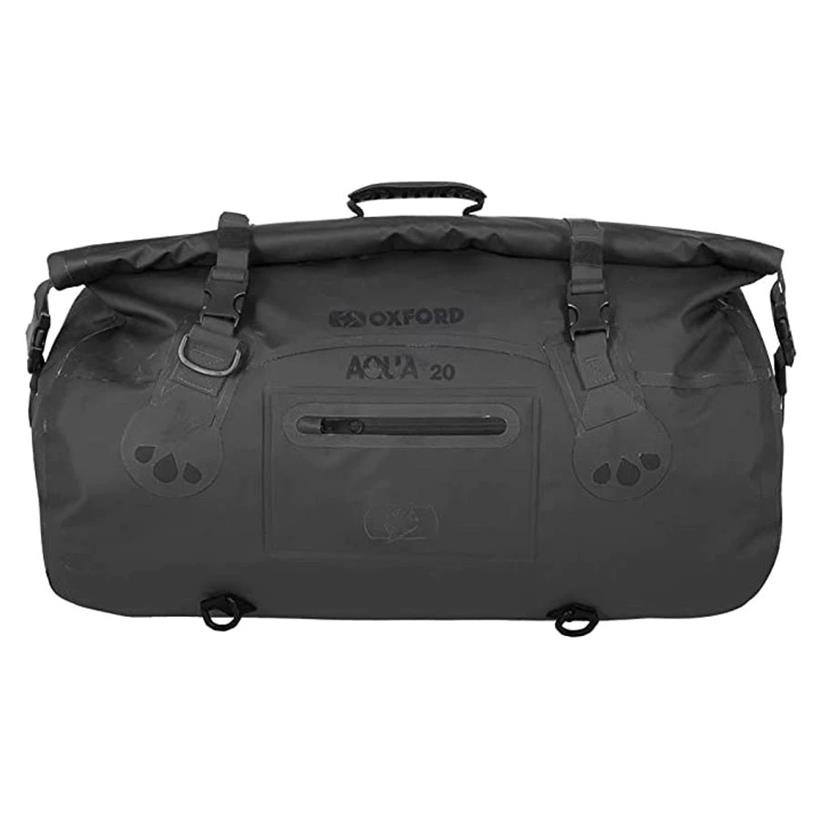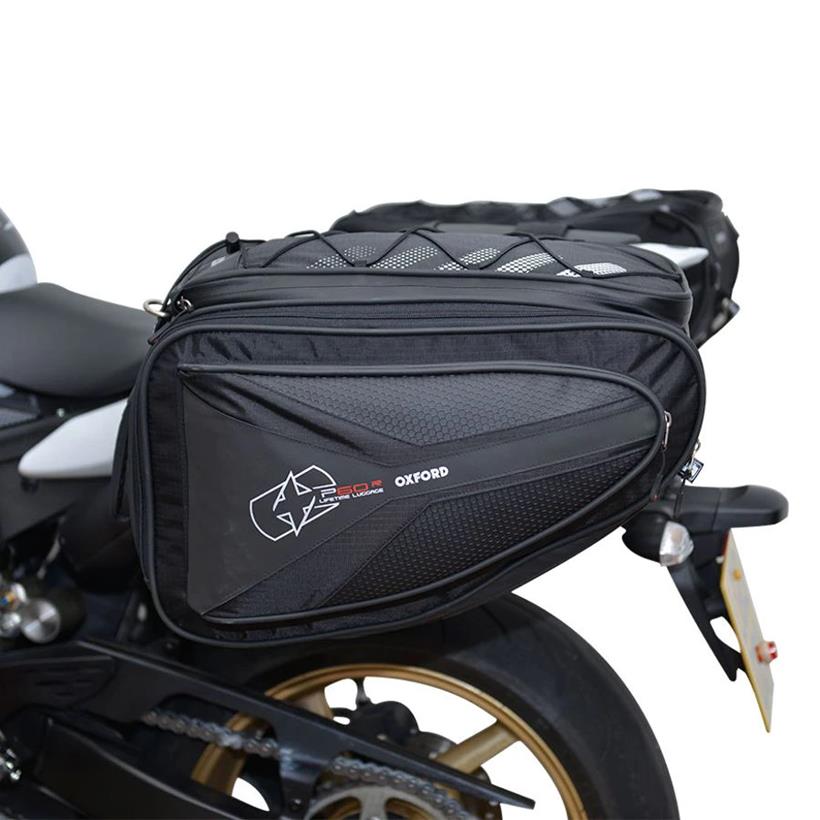Tried and tested: Royal Enfield official accessories review
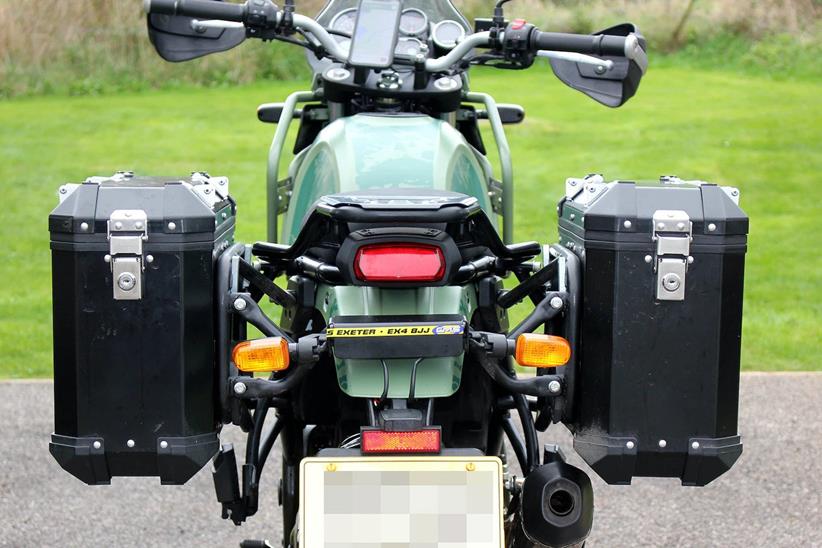
The Royal Enfield Himalayan is a great bike – but what about the aftersales accessories?
We’re going to have a look at a couple of the more popular items here and work out whether they are worth getting directly from the manufacturer, plus some aftermarket options that could be equally suitable.
Royal Enfield Phone Mount
There is more to mounting a phone or sat nav to your bike than whacking a proprietary mount on and off you go. You need to be able to mount your phone safely and securely yet not so that it can be affected by vibrations that can kill iPhones; ensure you can see the screen for directions, and make sure it doesn’t get in the way of your view of the road or the bike’s dash.
It can be a tricky task and one that I tackled on my Royal Enfield Himalayan initially with a standard handlebar adapter to fit my Quadlock mount to the bar clamp in the centre of the bars. However, this was far from ideal, as the bars were mounted very low compared to my view ahead and so I had to make a very conscious dip of the chin to check directions on the sat-nav app and in that process, take my eyes off the road.
However, a far better mounting option is available from Enfield Accessories; it produces two mounts, one using the screen-fixing screws and another, ‘mini’ mount that fixes on the gauge-mounting pins and locates the phone or sat-nav mount of choice above the dials but still protected behind the bike’s screen.
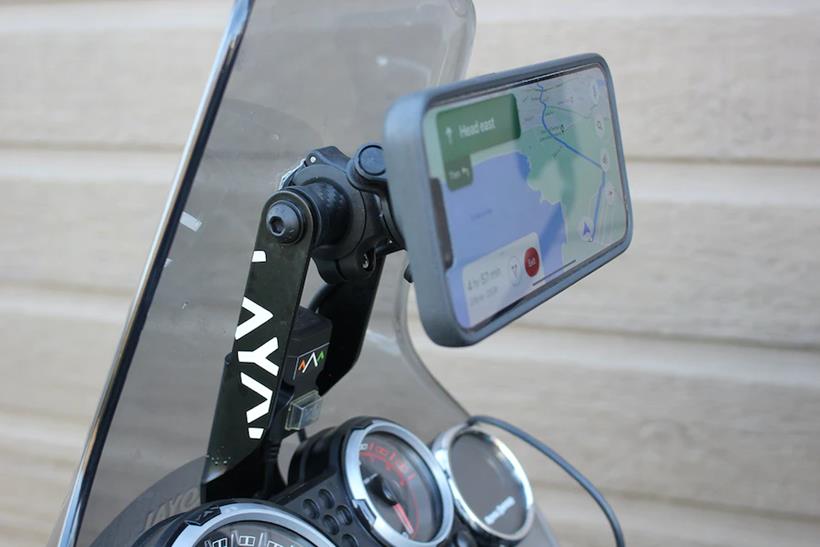

Pros
- Locates device in perfect view
- Well-made and comes with USB socket
- Easy to fit and great value
Cons
- Device mount can hit the screen
I got one of the first examples for the Euro5 bike, fitted with Enfield’s Tripper sat nav unit from the factory but I’d found this to be too difficult to use and wanted my smartphone ahead of me to use good old googlemaps. However, this meant that I had to wait for the company to finish developing the newer version, since the EU5 bike uses a different shaped screen to earlier models and hence, they would not fit.
Once it arrived, it was clear it was well developed and very nicely made. Formed in thick steel and powder-coated in black with branded logos on the side, the bracket features a short circular bar in carbon-fibre trim to mount your device to using its original system. It also comes with a switched USB power socket built in, with a detachable wiring loom, to provide power for whatever device you want to use.
Fitting the mount is straightforward; you begin by removing the screen (four screws) then the dial cluster (three nylok nuts on the back). You move the gauges rearwards off the mounting plate and fit the phone mount behind them, between them and the plate. As the phone mount only used two of the dials’ mounting-bolt holes, I added a washer roughly the same thickness as the mount to the third bolt to make sure the dials sat flush once they had been refitted.
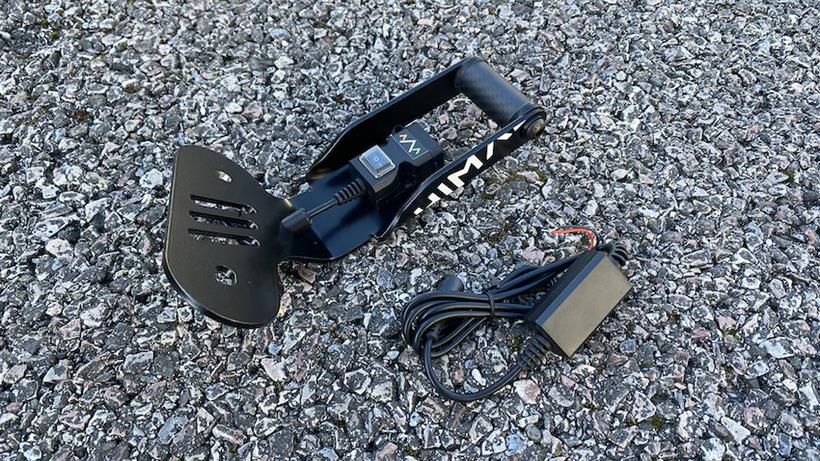
With the mount fitted and the nuts done back up, I trial fitted the screen again and realised that I would need to add some packing material to the back of the Quadlock handlebar mounting bracket as it was going to contact the screen and could cause issues. I used a small piece of foam held in place with every engineer’s best friend, tank tape and then, re-fitted the screen.
The result was the phone was now located in exactly the right place; it was far enough out of my eyeline that it didn’t interfere with the view from the bike, but it was easy to glance down at for directions. It sits behind the screen, so it is protected – even though it is supposed to be waterproof – and the mount is solid enough that I have no concerns about my phone dropping into the middle lane of the motorway and reverting to its component parts.
Verdict
This is an inexpensive but well designed and executed way of mounting a smartphone or device in just the right spot to be able to see it. It is well made from quality materials and fits well.
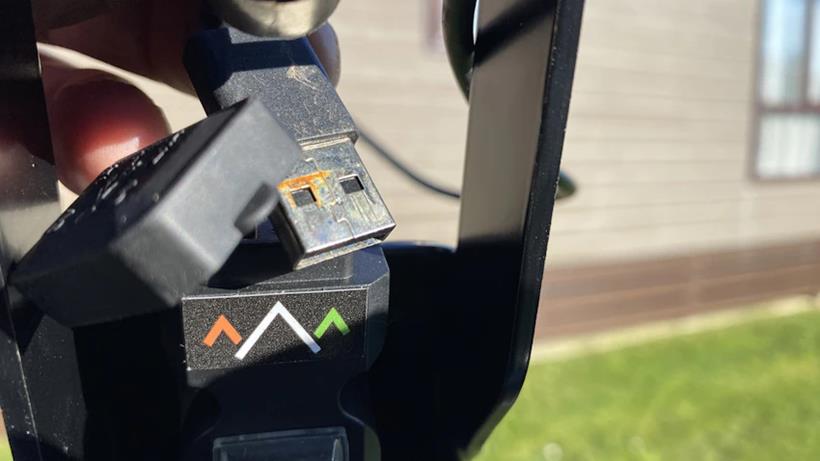
The additional of the switched USB power socket for your device is a really nice touch and once connected, will supply juice to your device or smartphone, which can be notoriously power-hungry when using sat-nav apps. It’s also excellent value at £49.99 while there is a chunkier version for larger or multiple devices for £79.99. The version for older bikes (Euro4) is £44.99.
Royal Enfield Himalayan Offical Panniers
There are some – myself included – that feel an adventure bike ought to look like an adventure bike all the time. And part of any adventure bike’s essential wardrobe is a pair of panniers like these Lomo Dry Bags.
Many will also wear a top box, but for me, a pair of panniers offer a great carry capacity in their own right and also allow you more to be added by strapping a rollbag or other luggage across the top, forming a stable platform in the process.
Related: Triumph Tiger 900 luggage reviewed
There are many manufacturers of both hard and soft panniers to fit a variety of bikes, but one of the most inexpensive options for the Royal Enfield Himalayan come from Enfield itself. This pair of aluminium panniers are available in either silver or black as seen here and with the necessary mounting frames, costs just £569.99.
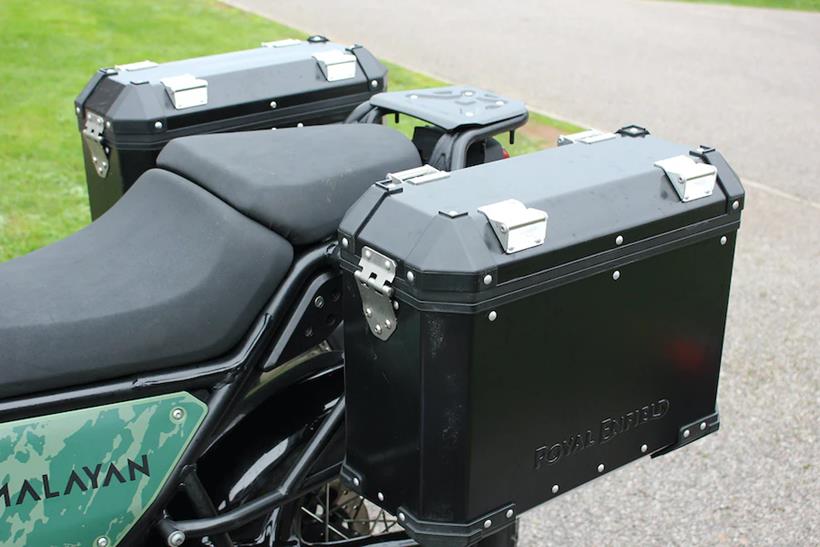

Pros
- Add around 60 litres of luggage capacity
- Look the part and appear well made
- Easy to load and lockable
Cons
- Catches wear mounting rails and may cause corrosion
Related: Best motorcycle luggage accessories
That might seem like a lot of money but compare it with a sports-tourer from a Japanese manufacturer where plastic panniers and the mounting kit can easily add £1000 to the price of the bike…
Like the bike itself, the panniers and mounts are uncomplicated but effective. The frames bolt to the side of the bike. This requires the indicators to be relocated from the plastic bodywork to brackets on a new rear-light housing but other than that, it’s simple.
The frames are a basic, rectangular shape of tubular steel and the panniers fit with a mount point in each corner. The bottom two simply hook onto the frames, while the top two have swinging bars on the outside that are tightened from inside to hold them against the top of the frame. The panniers each have a lock on the clasp, and there are four lashing points on top of each to mount an additional kit or luggage.

The panniers hinge from one end and open from the other. Typically, the locking mechanism would be located at the rear to protect them from the weather. This means that they open forward and have a rough capacity of 30 litres each, based on their dimensions – the capacity is not published anywhere. The sides of the panniers are in 2mm aluminium and thicker material is used on the base – 2.6mm – for extra strength and protection if stood on the ground.
They are a decent size – 30-odd litre is a good capacity. Yet unlike many touring panniers, they open from the top, not the side. This may make loading a little more difficult, but it does mean that you don’t scatter the contents over the ground when you do open them.
Sadly, they are not big enough for a spare helmet, but I can get my usual commuting Alpinestars laptop rucksack in one pannier, and in the other, all manner of stuff; clothes for a day in the office, locks, chains, visor cleaning gear, luggage straps, spare visor. I could probably fit some sandwiches in there, even…

The published limits are fairly low, as they are on many bikes, to ensure stability. A warning sticker inside states no more than 5kg in each pannier (two-and-a-half bags of sugar or 2L bottles of water) and no more than 70mph on the road. You may… ahem… be able to carry quite a lot more than that in each pannier and perhaps… ahem… go a little quicker than that and notice no ill-effects whatsoever but clearly, that is your personal choice. Ahem…
Adding the panniers to the bare bike inevitably adds some width and indeed, they are slightly wider than the bars at the front – about 10mm on each side. But like a cat, if the bars go through a gap, then they almost certainly will too. This is generally fine, for example filtering between lanes in heavy traffic but you do need to be aware that there is extra width behind you before you go piling through waves of traffic or attempt to squeeze between narrow gaps while turning.
You’ll notice from the photos that the tops of the panniers appear to be almost perfectly in line with the luggage rack on the tock bike. Whether by design or coincidence, it does make a very stable platform to start loading additional luggage on.

In fact, I recently did a 420-mile two-day round trip with both panniers full and a 50-litre roll bag, also full, strapped across the back and with the exception of the fuel consumption (which was more down to motorways instead of rural lanes than load, I suspect) the bike felt virtually no different.
Verdict
Admittedly I haven’t tried any other panniers, but I really like the genuine Enfield ones. They look the part, seem well made (although the hard-edged catches inevitably wear the paint on the mounting frames) and hold what I need them to for commuting or longer trips.
According to Enfield, they are not waterproof (the brand suggests optional drybags) but other than one washing incident, I haven’t had any water leaks and I’ve been through some horrific weather. They’re not cheap but then, no decent luggage is but I feel they are an investment worth making.
More motorcycle luggage options:
- Just so you know, we may receive a commission or other compensation from the links on this website - read why you should trust us.
